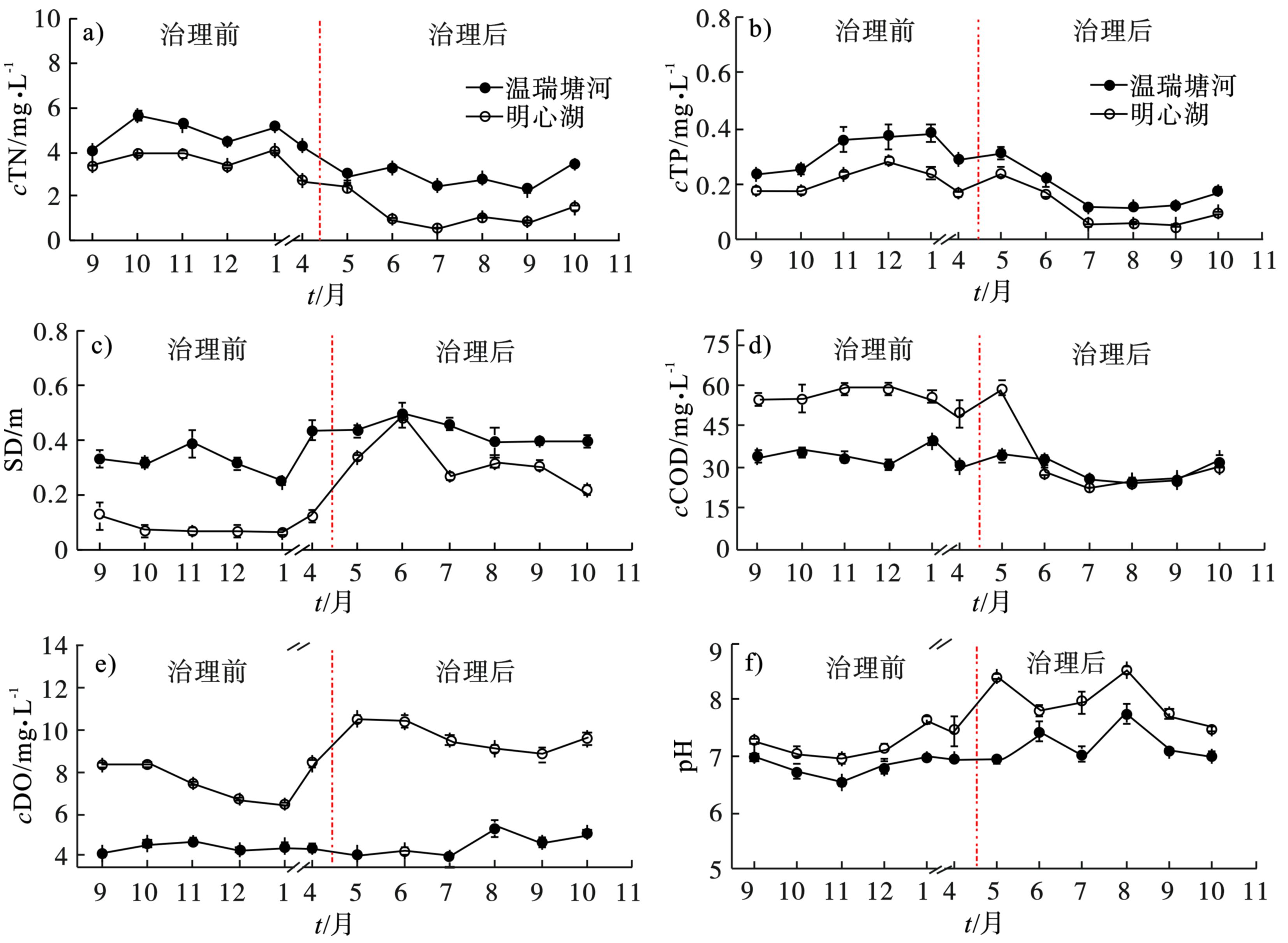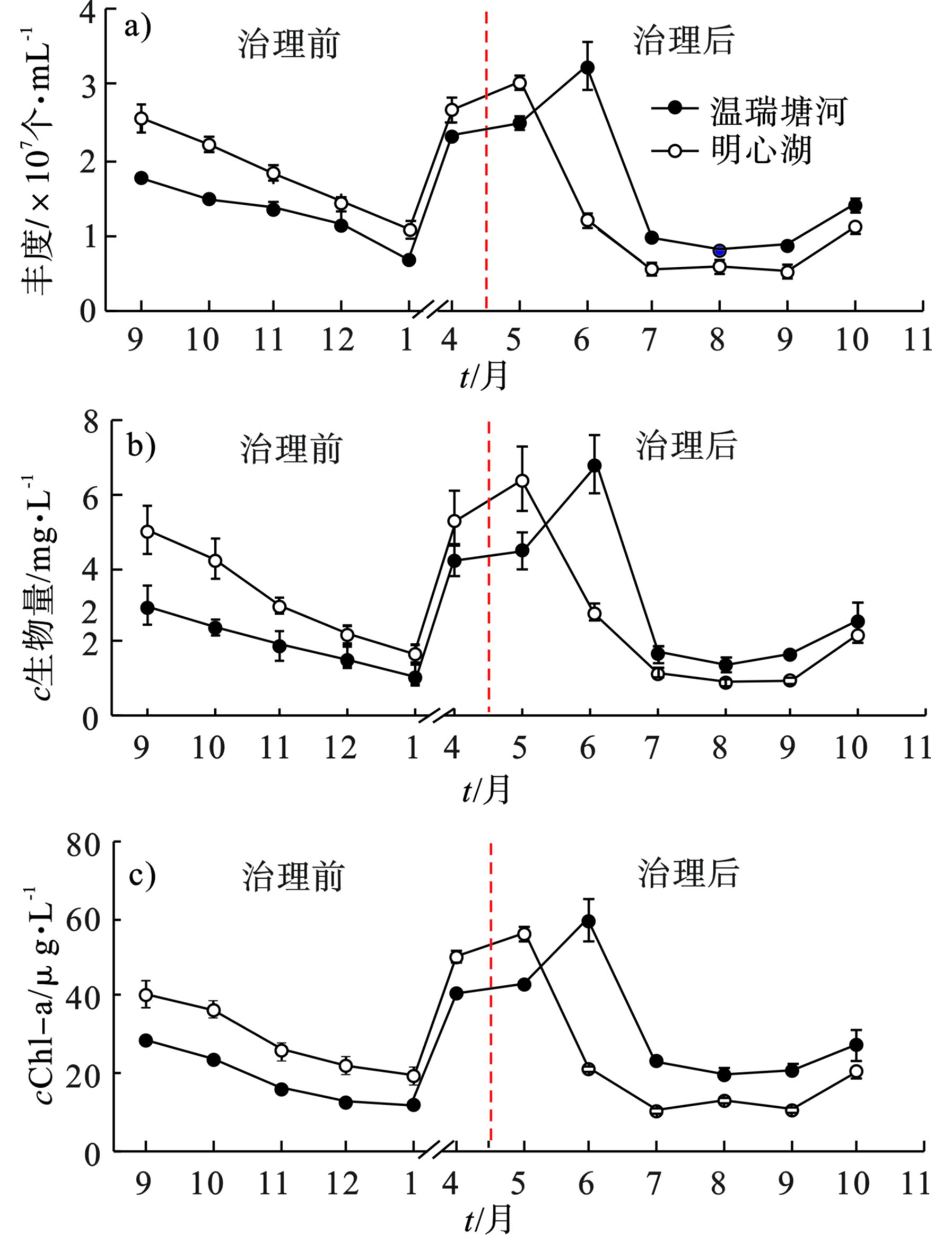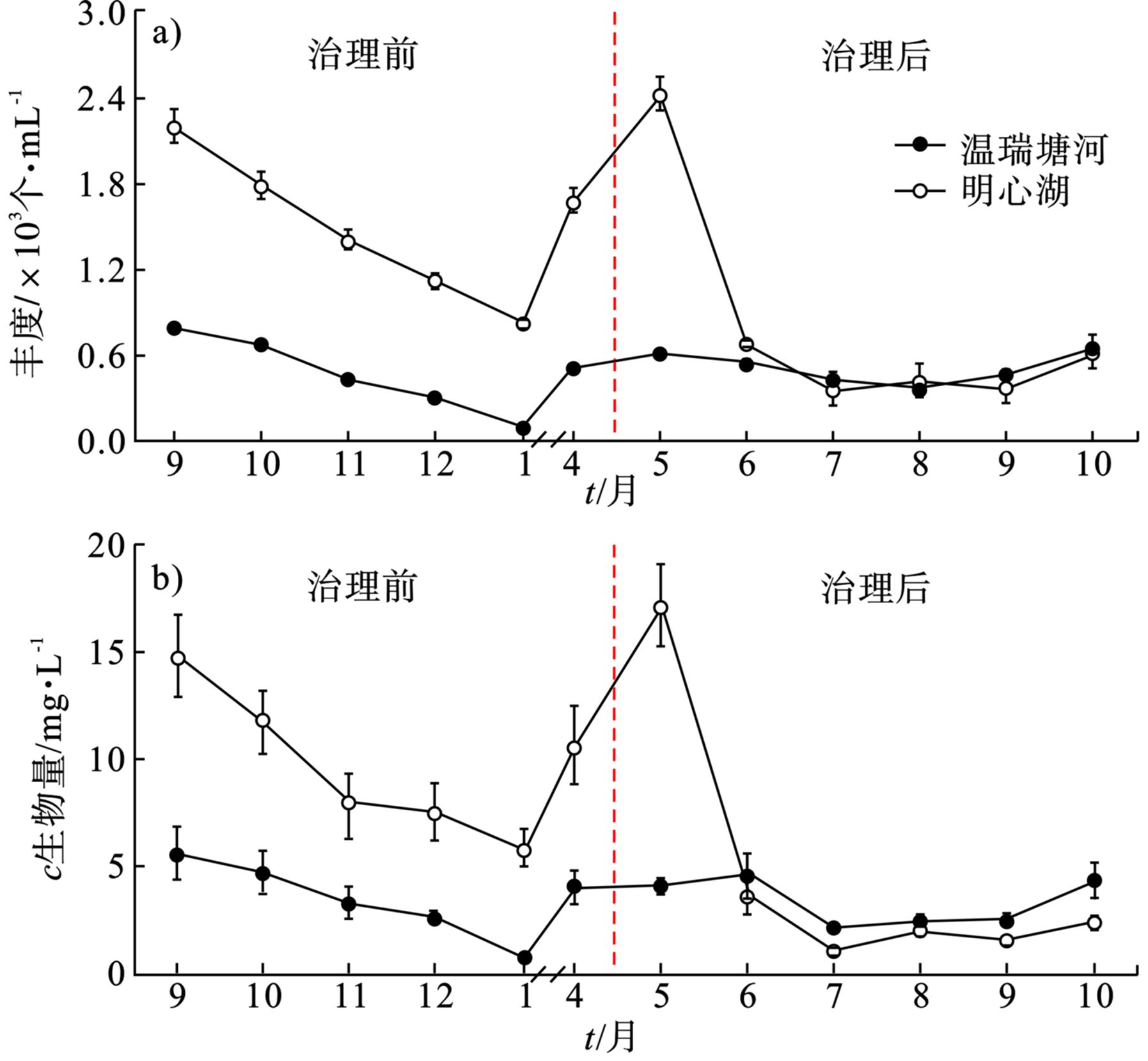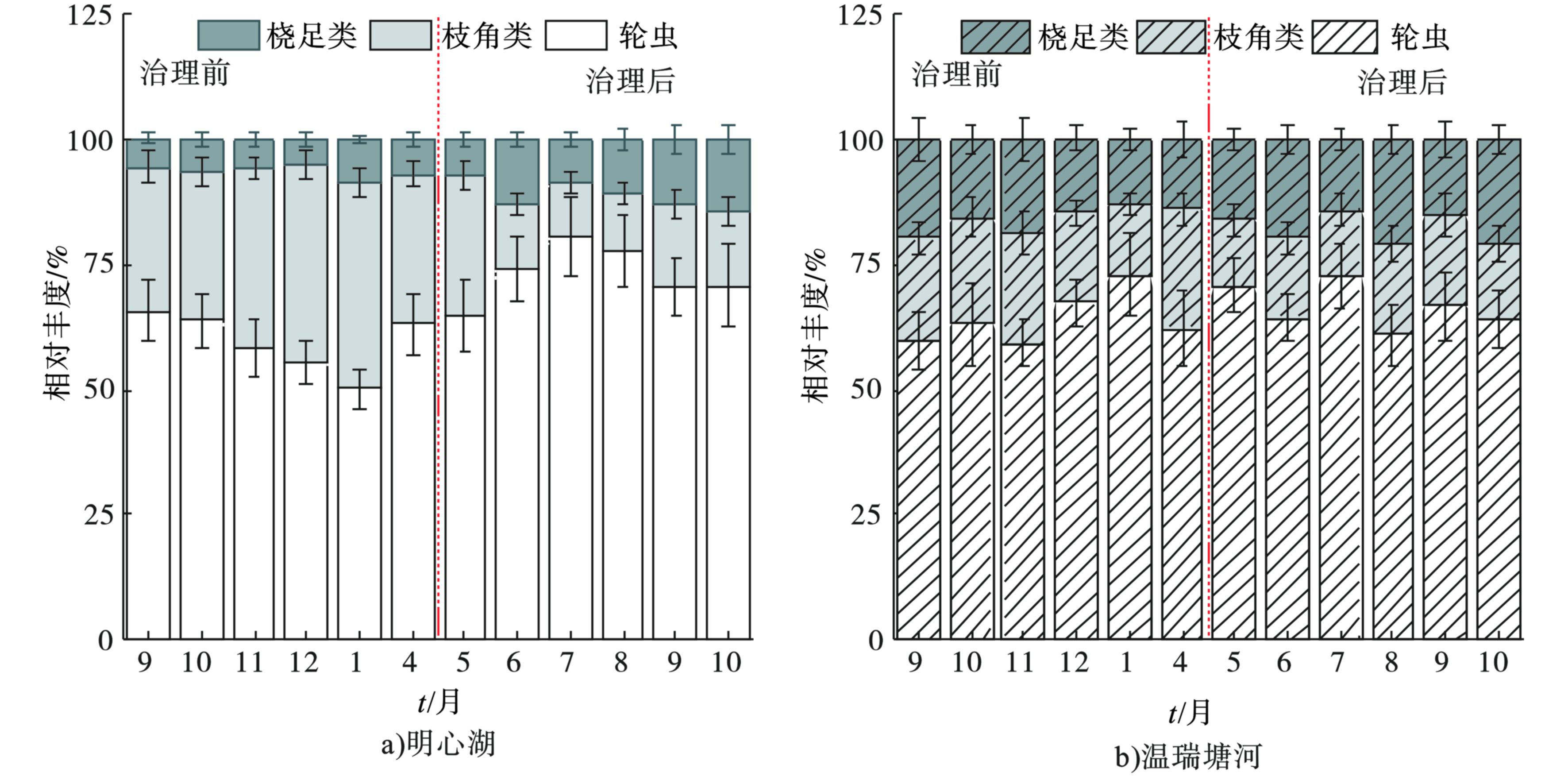-
我国幅员辽阔,湖泊众多,全国1 km2以上的湖泊有2 759个,总面积达91 019 km2,占国土面积的0.95%[1]。近年来,随着社会发展和人们生活水平的不断提高,城市建设越来越强调生态元素及理念,因此建设了大量的水体景观工程,即人工湖[2]。城市小型湖泊及人工湖能够影响城市微气候,促进物质和能量循环并参与生物修复过程,还具重要的美学和娱乐价值[2-3],以及重要的生态意义[4-5]。然而,这类湖泊通常水域面积较小、水深较浅、流速小、污染源受纳量较高且自净能力有限,容易出现水体富营养化[6-9]。近5年来,我国城市湖泊富营养化日趋严重,浮游藻类大量繁殖会破坏湖泊原有的自然景观,限制城市旅游业的发展,也降低了人民群众的幸福感[5]。
富营养化城市湖泊的治理已成为国内外学者广泛关注的焦点。自20世纪80年代初开始,国内外学者就开展了湖泊生态治理的实践研究。经过近40年的发展,底泥疏浚、人工曝气、水生植物种植等[10-13]生态治理技术得到广泛应用,且均取得了一定成效。但在实际应用中还需要依据每个湖泊的特点,因地制宜地选择相应的某种或者多种生态治理技术对湖泊进行治理。
温州大学明心湖是一个小型人工湖,占地面积约20 000 m2,平均水深0.50 m,因在湖中养有黑天鹅等水禽,又称“天鹅湖”。近年来,明心湖水体富营养化问题日趋严重,湖水透明度低且TN、TP、COD等多项指标高于地表Ⅴ类标准,浮游植物大量繁殖聚集而形成水华。为提升明心湖景观、改善水质,学校于2020年4~5月实施了疏浚、曝气以及水生植物种植等多项生态治理措施。为探究此次生态治理工程的治理效果,本研究分别对工程治理前后的水质及浮游生物群落结构变化进行了为期6个月的连续监测,对明心湖的主要水源温瑞塘河河道进行了同步监测并以此作为对照进行对比分析;在对生态治理工程治理前后明心湖水质及浮游生物群落结构变化的监测分析的基础上,评估生态治理工程对小型富营养化湖泊的治理效果,旨在为此类小型人工湖的日常维护与生态治理治理提供参考样本和数据支持。
-
温瑞塘河位于瓯江以南、飞云江以北的温瑞平原,是温州市境内十分重要的河道水系。水源主要来自瞿溪、雄溪、郭溪以及大罗山和集云山的山涧溪流,整个流域面积740 km2,水面面积22 km2,灌溉面积3 213 km2。温瑞塘河水质满足Ⅳ类水要求的河段长度仅占15.0%,Ⅴ类及劣于Ⅴ类河段占85.0%,河床平均淤积层达0.8 m,最深达2.2 m,有大量的内源污染[14]。
明心湖位于浙江省温州市温州大学校园内,主要靠从旁边的温瑞塘河支流抽取河水进行补水。为了全面监治理前后明心湖水体理化指标及浮游生物群落的变化,在明心湖内设置了4个采样位点 ,分别为位点1# (27°55′02″N, 120°41′48″E)、位点2# (27°55′03″N, 120°41′46″E)、位点3# (27°55′03″N, 120°41′45″E)、位点4# (27°55′05″N, 120°41′44″E)。此外,由于明心湖补水主要从旁边的温瑞塘河抽取,所以在温瑞塘河河道内也设置了4个采样位点作为对照,分别为位点5# (27°55′12″N, 120°41′41″E)、位点6# (27°55′09″N, 120°41′46″E)、位点7#(27°55′05″N, 120°41′52″E)、位点8# (27°55′01″N, 120°41′57″E)。
-
理治措施主要包括3方面: 将湖中水体排空,对湖底进行冲洗并清淤,厚度约0.20 m,清除明心湖底表层沉积物,防止沉积物中营养盐再次向上覆水体释放; 从温瑞塘河支流中抽取河水,经砂砾过滤后注入湖中,水深达到0.50 m左右,在湖底种植莲属植物(荷花、睡莲)、苦草和轮叶黑藻等水生植物,种植面积约占湖底面积的80%,以改善景观并利用水生植物吸收水体中的营养盐与污染物,净化水质并恢复水体生态功能; 禁养黑天鹅等水禽并采用喷泉曝气机进行曝气,以减少有机污染源并增加水体溶解氧含量,从而提高有机污染物的氧化降解速率。采用以上生态治理措施对明心湖治理后,温州大学明心湖的景观改善显著,水生植物生长状况良好、水生动物丰富度增加、生态系统质量优良。
-
参照《水质采样方案设计技术规定:HJ 495—2009》和《水质采样技术指导:HJ 494—2009》的相关要求,依据《水质样品的保存和管理技术规定:HJ 493—2009》相关规范,采用便携式多参数水质分析仪 (HACHHQ40d,哈希,美国) 现场测定水温、pH、DO;采用便携式电导率仪 (DDBJ-350F,上海雷磁,中国) 现场测定电导率;采用塞氏黑白盘测定SD;采用丙酮法测定Chl-a质量浓度;采用重铬酸盐法测定COD;采用碱性过硫酸钾消解紫外分光光度法测定TN质量浓度;采用过硫酸钾消解钼酸铵分光光度法测定TP质量浓度;采用分光光度法测定NO3-N质量浓度;采用纳氏试剂分光光度法测定NH4+-N质量浓度;采用钼酸铵分光光度法测定PO43-P质量浓度。
-
浮游植物样品采集方法参照章宗涉等[15]的研究。在采集样品过程中,使用伸缩杆控制网孔直径为0.064 mm的25号浮游生物网,在水面以“∞”状拖动浮游生物网,重复多次。采集的水样装入50 mL聚乙烯样品瓶,加入样品体积2%~4%的甲醛溶液固定保存样品,用于浮游植物的定性检测。用采水器采集水样1 L,注入聚乙烯样品瓶中并加入15 mL鲁哥氏液 (Lugol’s solution) 及样品体积2%~4%的甲醛溶液混匀,用于浮游植物样品的固定保存与定量检测。浮游植物定量检测时,充分摇匀后,吸取0.1 mL水样置于0.1 mL浮游生物计数框内 (面积为20 mm×20 mm),在10×40倍光学显微镜下进行计数。浮游植物丰度的计算,见式 (1):
式中:N为1 L水样中浮游植物个体数,个/mL(浮游动、植物细胞以“个”计数) ;V为水样体积 ,mL;Vs为浓缩样体积,mL;Va为计数体积,mL;n为计数所获得的个体数。浮游植物生物量浓度采用各种浮游植物的平均质量乘以丰度来计算,平均质量的计算参照《湖泊生态调查观测与分析》中的方法。
-
本研究采用Phyto-PAM浮游植物分析仪 (Heinz Walz GmbH,Effeltrich,Germany) 测定水样的Chl-a浓度,并将水样中的浮游植物按照蓝藻、绿藻、褐藻 (硅藻+甲藻) 种群进行群落类型的区分[16-18]。
-
使用伸缩杆控制25号浮游生物网做“∞”字形运动,缓慢拖动3~5 min,将样品用100 mL聚乙烯样品瓶收集,并立即加入样品体积3%~5%的甲醛溶液,用于浮游动物的定性检测。定量样品用2 L采水器采集,采集水样总计20 L。所有水样经25 号浮游生物网过滤后,用1 L聚乙烯样品瓶收集,之后加入甲醛溶液固定。带回实验室静置24 h,浓缩至100 mL后,倒置显微镜下鉴定并计数。浮游动物丰度的计算方法与浮游植物丰度的计算方法相同。浮游动物生物量浓度采用各类群浮游动物的平均质量乘以丰度来计算。平均质量参照《淡水浮游动物的定量方法》中的方法。
-
采用 SPSS 22.0软件对水质参数进行单因素方差分析 (One-way ANOVA),以检验各采样点之间水环境因子是否存在显著差异。采用OriginPro 2020进行浮游植物与水质相关性分并绘图。采用优势度 Y 来表征浮游动、植物种类结构特征,计算方法,见式 (2) :
式中:N为样品中所有种的细胞总数;Ni为样品中第i种的细胞数;fi为第i种在各采样点出现的频率。取浮游生物优势度 Y ≥ 0.02为优势种[19]。
-
检测结果表明,生态治理后,明心湖水体透明度显著升高,有机污染物含量显著下降,水质明显改善。明心湖和温瑞塘河治理前水质的变化,见图1。
图1 可知,治理后,明心湖表层水体的COD、TN、TP显著 (P<0.05) 下降。根据《地表水环境质量标准:GB 3838—2002》,治理后明心湖水体的TN平均质量浓度由Ⅴ类水水平 (>2.00 mg/L) 降至Ⅱ类水水平 (0.50~1.00 mg/L);TP平均质量浓度由Ⅴ类水水平 (0.20 mg/L)降至Ⅲ类水水平 (0.05 mg/L);平均COD由Ⅴ类水水平 (>40.00 mg/L)降至Ⅲ类水水平(20.00~30.00 mg/L),显示出了较好的治理效果。已有研究[20]表明,水生植物种植等生态治理措施能有效去除水体中的重金属、营养盐、有机与无机污染物,从而使湖泊的水质得到改善。
此外,SD平均值由治理前的0.14 m上升至0.31 m以上,DO平均质量浓度由治理前的7.06 mg/L上升至10.53 mg/L,而pH平均值由7.28上升至8.10。SD的显著 (P<0.05) 提升可能与底泥疏浚与水生植物种植有关[21]。水生植物可以通过吸附和过滤作用,降低生物性和非生物性悬浮物,增加透明度,净化水质[22];此外,其还可通过与浮游植物竞争营养物质和生长空间,形成遮光效应并分泌克藻物质,可以很好地抑制浮游藻类的过量繁殖,减少水华的暴发,维持较高的生物多样性和健康的水环境[23]。生态治理后,明心湖水体的DO显著 (P<0.05) 升高,这可能与曝气及禁养水禽后水体中有机污染物含量降低有关。
-
治理措施对明心湖浮游植物群落结构起到了改善作用。治理前后明心湖和温瑞塘河浮游植物的变化,见图2。
图2可知,治理前,明心湖中的浮游植物丰度、生物量和Chl-a质量浓度均显著 (P<0.05) 高于温瑞塘河,且变化趋势相似。治理前明心湖中的浮游植物的平均丰度为1.40×107 个/mL,平均生物量为3.14 mg/L,平均Chl-a质量浓度为28.34 µg/L;温瑞塘河中的平均浮游植物丰度为1.20×107 个/mL,平均生物量为3.37 mg/L,平均Chl-a质量浓度为18.25 µg/L。治理后,除5月份外,明心湖中的浮游植物丰度、生物量和Chl-a质量浓度均低于温瑞塘河,分别降低了17%、14%、18%。通常情况下,清洁水体中浮游植物的种类较多,而生物量较小[24-25]。治理后,明心湖中的浮游植物丰度、生物量及Chl-a质量浓度均显著 (P<0.05) 降低。已有研究[18, 26-27]表明,浮游植物丰度与水温、TN、TP、COD之间呈显著相关。
以不同类群浮游藻类即蓝藻、绿藻、硅藻的Chl-a含量与水体中总Chl-a含量的比值随时间的变化表示各种群相对丰度在一年中的消长状况,结果表明,明心湖和温瑞塘河的浮游植物全年以绿藻和硅藻为主,蓝藻主要在夏秋季出现,并且占比很小 。治理前后明心湖和温瑞塘河表层水体中浮游植物种群相对丰度的变化,见图3。
图3可知,治理前,明心湖和温瑞塘河的绿藻平均相对丰度分别为50%和45%,硅藻的平均相对丰度分别为50%和55%,未出现蓝藻。治理后,明心湖和温瑞塘河绿藻的平均相对丰度分别为69%和51%,硅藻的平均相对丰度分别为27%和42%,蓝藻的平均相对丰度分别为4%和7%。这表明生态治理后明心湖的水体更适宜绿藻生长。此外,明心湖和温瑞塘河全年的浮游植物群落类型为绿藻-硅藻型。
治理后,明心湖中绿藻种群的相对丰度显著增加 。监测结果表明,治理后绿藻单角盘星藻和空球藻的丰度和优势度显著 (P<0.05) 增加 ,见表2。文献[28-30]表明,曝气引起的浮游植物在垂直方向上的重新分布有利于浮游植物获取光和营养,能够显著提升绿藻和硅藻种群的生长。一般来说,硅藻的最佳生长温度为5~20 ℃ ,绿藻为15~30 ℃,而蓝藻在温度30 ℃以上也可以较好地生长[31-32]。因此,在春夏季节交替时,随着水温的升高,绿藻丰度会增加[33-34],相对丰度也会相应提高。治理前后,明心湖浮游植物种类数变化微小,且与温瑞塘河一致性较强。这可能是由于明心湖经常抽取温瑞塘河的河水进行补水所致。有研究[35-36]表明,引水水源与湖泊水质和浮游生物有显著相关性。而明心湖和温瑞塘河均在夏秋季节出现少量蓝藻,这也与已有的研究结果[18]一致。
治理前后,明心湖与温瑞塘河的浮游植物优势种均为硅藻和绿藻。治理前后明心湖和温瑞塘河浮游植物优势种及其优势度的变化,见表1。
表1可知,治理前,明心湖中优势度最大的浮游植物是颗粒直链藻 (Aulacoseira granulate) 和单角盘星藻 (Pediastrum simplex)、空球藻 (Eudorina sp.);温瑞塘河中优势度最大的浮游植物是脆杆藻 (Fragilaria sp.)和颗粒直链藻。治理后,明心湖与温瑞塘河浮游植物优势种仍有很多是相同的,包括脆杆藻、针杆藻 (Synedra sp.)、桥弯藻 (Cyclotella sp.)、变异直链藻 (Aulacoseira varians)、小环藻 (Cyclotella sp.)、衣藻 (Chlamydomonas sp.)、四尾栅藻 (Scenedesmus quadricauda)和鼓藻 (Cosmarium sp.) 等。但是优势度有较大差别,其中明心湖中脆杆藻和针杆藻的优势度显著 (P<0.05) 低于温瑞塘河。治理后,明心湖裸藻的优势度显著 (P<0.05) 降低,而单角盘星藻和空球藻优势度显著 (P<0.05) 增加。
-
治理后明心湖浮游动物的丰度与生物量显著 (P<0.05) 降低 ,并且与水体中浮游植物丰度的变化趋势一致。治理前后明心湖和温瑞塘河中浮游动物丰度和浓度的变化,见图4。
治理前,明心湖中的浮游动物丰度 (图4a) 和生物量 (图4b) 均显著 (P<0.05) 高于温瑞塘河,其平均丰度分别为1 508.00和486.00个/L,平均生物量分别为9.60和3.47 mg/L。治理后,除了在5月份明心湖的浮游动物丰度和生物量显著 (P<0.05) 高于温瑞塘河外,其他月份均略低于温瑞塘河。治理后,明心湖和温瑞塘河中浮游动物的平均丰度分别为825.00和514.00个/L,平均生物量分别为4.63和3.25 mg/L。这可能与浮游动物种群丰度的变化主要受饵料供应调控有关[29, 37]。浮游动物是水体中较为敏感的环境指示生物[38],同时水体中其他环境因素 (如水温、溶解氧等,以及鱼类等) 对浮游动物的摄食压力都会对其群落结构产生重要影响[39-40]。
与温瑞塘河相比,治理后明心湖中的桡足类中近邻剑水蚤优势度显著增加。治理前后明心湖和温瑞塘河表层水体中浮游动物种群相对丰度的变化,见图5。
治理前,明心湖 (图5a) 与温瑞塘河 (图5b) 浮游动物相对丰度的变化均不显著 (P>0.05) ,且轮虫占比均较大。治理后,明心湖中桡足类占比有所增加,枝角类占比则有所降低,轮虫仍占绝对优势。治理前明心湖中桡足类、枝角类和轮虫类的平均相对丰度为7%、36%和57%,而治理后三者的平均相对丰度为11%、14%和75%。与之相对应,治理前,同一时段温瑞塘河中桡足类、枝角类和轮虫类的平均相对丰度为17%、22%和61%,而治理后同一时段三者的平均相对丰度为20%、15%和65%。
治理后,明心湖与温瑞塘河中浮游动物优势种的多样性有所增加。治理前后明心湖和温瑞塘河浮游动物优势种及其优势度的变化,见表2。
表2可知,治理前后,明心湖与温瑞塘河中浮游动物优势种均为轮虫和枝角类 ,且治理前后明心湖中优势度最大的浮游动物分别是平突船卵溞 (Scapholeberis kingi) 和螺形龟甲轮虫 (Keratella cochlearis);温瑞塘河中优势度最大的浮游动物分别是针簇多肢轮虫 (Polyarthra trigla) 和矩形龟甲轮虫 (Keratella quadrata)。治理前后,明心湖与温瑞塘河中相同的浮游动物优势种包括裂足臂尾轮虫 (Brachionus diversicornis)、裂痕龟纹轮虫 (Brachionus fissa)、螺形龟甲轮 、矩形龟甲轮虫、针簇多肢轮虫、萼花臂尾轮虫 (Brachionus calyciflorus)、长肢秀体溞 (Diaphanosoma leuchtenbergianum)、近邻剑水蚤 (Cyclops vicinus)和广布中剑水蚤 (Mesocyclops leuckarti)等。治理后,明心湖中枝角类平突船卵溞和长肢秀体溞的优势度显著 (P<0.05) 降低,而长额象鼻溞 (Bosmina longirostris) 和多刺裸腹溞 (Moina macrocopa) 的优势度有所增加。治理后,明心湖与温瑞塘河中浮游动物优势种的多样性有所增加,这可能与水质改善有关。水体富营养化会降低浮游动物的物种多样性,抑制非耐污种的生长[41-42]。治理前后,轮虫的相对丰度在温瑞塘河与明心湖中均占比较高 ,见图5,壶状臂尾轮虫 (Brachionus urceus) 优势度显著 (P<0.05) 降低。耐污的枝角类平突船卵溞、长肢秀体溞以及壶状臂尾轮虫丰度的优势度的降低(图5 b, 表3) 可能也与水质改善有关。枝角类作为浮游甲壳动物的一种,广泛分布在淡水中,经常在在富营养化的水体中大量暴发,当水体富营养化程度降低时,暴发情况会减弱[5, 43]。如耐污种微型裸腹溞,一定程度上可以作为判别水体富营养化程度的指示生物[44]。在对江苏省宜兴市的临溪河进行生态治理后,该水体中的轮虫优势种由治理前的壶状臂尾轮虫等耐污种转变为了针簇多肢轮虫等寡污种[45]。
-
(1)生态治理治理后,温州大学明心湖的水质得到了明显改善,COD、TN 、生物量和TP质量浓度显著降低,DO、SD和pH显著上升,表明生态治理对该类型湖泊的水质改善效果较好。
(2)治理后,浮游植物种类及优势种变化不显著,但浮游植物丰度、浓度和Chl-a质量浓度显著降低。同时,绿藻的相对丰度显著增加,单角盘星藻和空球藻等绿藻的优势度显著上升,表明治理后水质改善有利于绿藻的生长。
(3)治理后,浮游动物的丰度和生物量均显著降低,枝角类的相对优势度显著下降。而桡足类和轮虫类的相对丰度显著增加。这表明水质改善及浮游植物丰度的变化对浮游动物种群具有调控作用。
富营养化浅水湖泊生态治理措施及效果
——以温州大学明心湖生态治理工程为例Effects of ecological restoration measures on eutrophic shallow lakes
-
摘要: 温州大学明心湖长期以来水体透明度偏低且近岸时常出现水华现状,文章于2020年4~5月对该湖实施了底泥疏浚、水生植物种植、曝气等生态治理工程,并通过对治理前后其水质及浮游生物群落结构定期监测。结果表明:治理后5个月,明心湖水体的TN、TP和COD显著下降,分别从3.31、0.17和51.03 mg/L降至0.81、0.05和25.26 mg/L;SD、DO和pH平均值显著升高,分别由0.14 m、7.06 mg/L、7.28升至0.31 m、10.53 mg/L和8.10;浮游生物的丰度均显著下降,浮游植物中绿藻的相对丰度显著上升,而浮游动物中枝角类和轮虫类的相对丰度显著下降。综上,生态治理工程实施后,明心水体透明度显著提高,营养盐水平、叶绿素a浓度及浮游生物丰度显著下降。Abstract: Mingxin Lake, a small, eutrophic and shallow lake located in the campus of Wenzhou University, has a long history of low transparency and frequent occurrence of algal blooms near the shore. To improve the situation, the ecological restoration projects including dredging, cultivation of aquatic plants and aeration were performed in the Mingxin Lake from April to May in 2020, and the effects of these ecological restoration projects were evaluated by the regular monitoring of the water quality and the plankton community of the Mingxin Lake before and after the treatment. The results showed that levels of TN, TP and COD in the Mingxin Lake significantly reduced after the implementation of the ecological restoration projects. In 5 months, the average concentration of TN, TP and COD in the Mingxin Lake decreased to 0.81, 0.05 and 25.26 mg/L from 3.31, 0.17 and 51.03 mg/L, respectively. On the other hand, the SD, DO and pH of waters increased significantly. The average SD increased from 0.14 m to 0.31 m in 5 months, the average concentration of DO increased from 7.06 mg/L to 10.53 mg/L, and the average pH value increased from 7.28 to 8.10. After implementation of the ecological restoration projects, the plankton abundance in the Mingxin Lake decreased significantly. The relative abundance of green algae in total phytoplankton increased significantly, while the relative abundance of cladocerans and rotifers in total zooplankton decreased significantly. In conclusion, the water quality in the Mingxin Lake improved significantly after the implementation of the ecological restoration projects, the transparency significantly improved, the nutrient level and the chlorophyll a concentration as well as the plankton abundance significantly decreased.
-
我国幅员辽阔,湖泊众多,全国1 km2以上的湖泊有2 759个,总面积达91 019 km2,占国土面积的0.95%[1]。近年来,随着社会发展和人们生活水平的不断提高,城市建设越来越强调生态元素及理念,因此建设了大量的水体景观工程,即人工湖[2]。城市小型湖泊及人工湖能够影响城市微气候,促进物质和能量循环并参与生物修复过程,还具重要的美学和娱乐价值[2-3],以及重要的生态意义[4-5]。然而,这类湖泊通常水域面积较小、水深较浅、流速小、污染源受纳量较高且自净能力有限,容易出现水体富营养化[6-9]。近5年来,我国城市湖泊富营养化日趋严重,浮游藻类大量繁殖会破坏湖泊原有的自然景观,限制城市旅游业的发展,也降低了人民群众的幸福感[5]。
富营养化城市湖泊的治理已成为国内外学者广泛关注的焦点。自20世纪80年代初开始,国内外学者就开展了湖泊生态治理的实践研究。经过近40年的发展,底泥疏浚、人工曝气、水生植物种植等[10-13]生态治理技术得到广泛应用,且均取得了一定成效。但在实际应用中还需要依据每个湖泊的特点,因地制宜地选择相应的某种或者多种生态治理技术对湖泊进行治理。
温州大学明心湖是一个小型人工湖,占地面积约20 000 m2,平均水深0.50 m,因在湖中养有黑天鹅等水禽,又称“天鹅湖”。近年来,明心湖水体富营养化问题日趋严重,湖水透明度低且TN、TP、COD等多项指标高于地表Ⅴ类标准,浮游植物大量繁殖聚集而形成水华。为提升明心湖景观、改善水质,学校于2020年4~5月实施了疏浚、曝气以及水生植物种植等多项生态治理措施。为探究此次生态治理工程的治理效果,本研究分别对工程治理前后的水质及浮游生物群落结构变化进行了为期6个月的连续监测,对明心湖的主要水源温瑞塘河河道进行了同步监测并以此作为对照进行对比分析;在对生态治理工程治理前后明心湖水质及浮游生物群落结构变化的监测分析的基础上,评估生态治理工程对小型富营养化湖泊的治理效果,旨在为此类小型人工湖的日常维护与生态治理治理提供参考样本和数据支持。
1. 研究区域与生态治理措施
1.1 研究区域
温瑞塘河位于瓯江以南、飞云江以北的温瑞平原,是温州市境内十分重要的河道水系。水源主要来自瞿溪、雄溪、郭溪以及大罗山和集云山的山涧溪流,整个流域面积740 km2,水面面积22 km2,灌溉面积3 213 km2。温瑞塘河水质满足Ⅳ类水要求的河段长度仅占15.0%,Ⅴ类及劣于Ⅴ类河段占85.0%,河床平均淤积层达0.8 m,最深达2.2 m,有大量的内源污染[14]。
明心湖位于浙江省温州市温州大学校园内,主要靠从旁边的温瑞塘河支流抽取河水进行补水。为了全面监治理前后明心湖水体理化指标及浮游生物群落的变化,在明心湖内设置了4个采样位点 ,分别为位点1# (27°55′02″N, 120°41′48″E)、位点2# (27°55′03″N, 120°41′46″E)、位点3# (27°55′03″N, 120°41′45″E)、位点4# (27°55′05″N, 120°41′44″E)。此外,由于明心湖补水主要从旁边的温瑞塘河抽取,所以在温瑞塘河河道内也设置了4个采样位点作为对照,分别为位点5# (27°55′12″N, 120°41′41″E)、位点6# (27°55′09″N, 120°41′46″E)、位点7#(27°55′05″N, 120°41′52″E)、位点8# (27°55′01″N, 120°41′57″E)。
1.2 明心湖生态治理措施
理治措施主要包括3方面: 将湖中水体排空,对湖底进行冲洗并清淤,厚度约0.20 m,清除明心湖底表层沉积物,防止沉积物中营养盐再次向上覆水体释放; 从温瑞塘河支流中抽取河水,经砂砾过滤后注入湖中,水深达到0.50 m左右,在湖底种植莲属植物(荷花、睡莲)、苦草和轮叶黑藻等水生植物,种植面积约占湖底面积的80%,以改善景观并利用水生植物吸收水体中的营养盐与污染物,净化水质并恢复水体生态功能; 禁养黑天鹅等水禽并采用喷泉曝气机进行曝气,以减少有机污染源并增加水体溶解氧含量,从而提高有机污染物的氧化降解速率。采用以上生态治理措施对明心湖治理后,温州大学明心湖的景观改善显著,水生植物生长状况良好、水生动物丰富度增加、生态系统质量优良。
2. 样品的采集与分析方法
2.1 样品的采集与处理
参照《水质采样方案设计技术规定:HJ 495—2009》和《水质采样技术指导:HJ 494—2009》的相关要求,依据《水质样品的保存和管理技术规定:HJ 493—2009》相关规范,采用便携式多参数水质分析仪 (HACHHQ40d,哈希,美国) 现场测定水温、pH、DO;采用便携式电导率仪 (DDBJ-350F,上海雷磁,中国) 现场测定电导率;采用塞氏黑白盘测定SD;采用丙酮法测定Chl-a质量浓度;采用重铬酸盐法测定COD;采用碱性过硫酸钾消解紫外分光光度法测定TN质量浓度;采用过硫酸钾消解钼酸铵分光光度法测定TP质量浓度;采用分光光度法测定NO3-N质量浓度;采用纳氏试剂分光光度法测定NH4+-N质量浓度;采用钼酸铵分光光度法测定PO43-P质量浓度。
2.2 浮游植物样品
浮游植物样品采集方法参照章宗涉等[15]的研究。在采集样品过程中,使用伸缩杆控制网孔直径为0.064 mm的25号浮游生物网,在水面以“∞”状拖动浮游生物网,重复多次。采集的水样装入50 mL聚乙烯样品瓶,加入样品体积2%~4%的甲醛溶液固定保存样品,用于浮游植物的定性检测。用采水器采集水样1 L,注入聚乙烯样品瓶中并加入15 mL鲁哥氏液 (Lugol’s solution) 及样品体积2%~4%的甲醛溶液混匀,用于浮游植物样品的固定保存与定量检测。浮游植物定量检测时,充分摇匀后,吸取0.1 mL水样置于0.1 mL浮游生物计数框内 (面积为20 mm×20 mm),在10×40倍光学显微镜下进行计数。浮游植物丰度的计算,见式 (1):
stringUtils.convertMath(!{formula.content}) (1) 式中:N为1 L水样中浮游植物个体数,个/mL(浮游动、植物细胞以“个”计数) ;V为水样体积 ,mL;Vs为浓缩样体积,mL;Va为计数体积,mL;n为计数所获得的个体数。浮游植物生物量浓度采用各种浮游植物的平均质量乘以丰度来计算,平均质量的计算参照《湖泊生态调查观测与分析》中的方法。
2.3 不同类群浮游植物相对丰度的确定
本研究采用Phyto-PAM浮游植物分析仪 (Heinz Walz GmbH,Effeltrich,Germany) 测定水样的Chl-a浓度,并将水样中的浮游植物按照蓝藻、绿藻、褐藻 (硅藻+甲藻) 种群进行群落类型的区分[16-18]。
2.4 浮游动物样品
使用伸缩杆控制25号浮游生物网做“∞”字形运动,缓慢拖动3~5 min,将样品用100 mL聚乙烯样品瓶收集,并立即加入样品体积3%~5%的甲醛溶液,用于浮游动物的定性检测。定量样品用2 L采水器采集,采集水样总计20 L。所有水样经25 号浮游生物网过滤后,用1 L聚乙烯样品瓶收集,之后加入甲醛溶液固定。带回实验室静置24 h,浓缩至100 mL后,倒置显微镜下鉴定并计数。浮游动物丰度的计算方法与浮游植物丰度的计算方法相同。浮游动物生物量浓度采用各类群浮游动物的平均质量乘以丰度来计算。平均质量参照《淡水浮游动物的定量方法》中的方法。
2.5 数据统计与分析
采用 SPSS 22.0软件对水质参数进行单因素方差分析 (One-way ANOVA),以检验各采样点之间水环境因子是否存在显著差异。采用OriginPro 2020进行浮游植物与水质相关性分并绘图。采用优势度 Y 来表征浮游动、植物种类结构特征,计算方法,见式 (2) :
stringUtils.convertMath(!{formula.content}) (2) 式中:N为样品中所有种的细胞总数;Ni为样品中第i种的细胞数;fi为第i种在各采样点出现的频率。取浮游生物优势度 Y ≥ 0.02为优势种[19]。
3. 结果与讨论
3.1 生态治理前后明心湖水质的变化
检测结果表明,生态治理后,明心湖水体透明度显著升高,有机污染物含量显著下降,水质明显改善。明心湖和温瑞塘河治理前水质的变化,见图1。
图1 可知,治理后,明心湖表层水体的COD、TN、TP显著 (P<0.05) 下降。根据《地表水环境质量标准:GB 3838—2002》,治理后明心湖水体的TN平均质量浓度由Ⅴ类水水平 (>2.00 mg/L) 降至Ⅱ类水水平 (0.50~1.00 mg/L);TP平均质量浓度由Ⅴ类水水平 (0.20 mg/L)降至Ⅲ类水水平 (0.05 mg/L);平均COD由Ⅴ类水水平 (>40.00 mg/L)降至Ⅲ类水水平(20.00~30.00 mg/L),显示出了较好的治理效果。已有研究[20]表明,水生植物种植等生态治理措施能有效去除水体中的重金属、营养盐、有机与无机污染物,从而使湖泊的水质得到改善。
此外,SD平均值由治理前的0.14 m上升至0.31 m以上,DO平均质量浓度由治理前的7.06 mg/L上升至10.53 mg/L,而pH平均值由7.28上升至8.10。SD的显著 (P<0.05) 提升可能与底泥疏浚与水生植物种植有关[21]。水生植物可以通过吸附和过滤作用,降低生物性和非生物性悬浮物,增加透明度,净化水质[22];此外,其还可通过与浮游植物竞争营养物质和生长空间,形成遮光效应并分泌克藻物质,可以很好地抑制浮游藻类的过量繁殖,减少水华的暴发,维持较高的生物多样性和健康的水环境[23]。生态治理后,明心湖水体的DO显著 (P<0.05) 升高,这可能与曝气及禁养水禽后水体中有机污染物含量降低有关。
3.2 生态治理前后明心湖浮游植物群落结构的变化
治理措施对明心湖浮游植物群落结构起到了改善作用。治理前后明心湖和温瑞塘河浮游植物的变化,见图2。
图2可知,治理前,明心湖中的浮游植物丰度、生物量和Chl-a质量浓度均显著 (P<0.05) 高于温瑞塘河,且变化趋势相似。治理前明心湖中的浮游植物的平均丰度为1.40×107 个/mL,平均生物量为3.14 mg/L,平均Chl-a质量浓度为28.34 µg/L;温瑞塘河中的平均浮游植物丰度为1.20×107 个/mL,平均生物量为3.37 mg/L,平均Chl-a质量浓度为18.25 µg/L。治理后,除5月份外,明心湖中的浮游植物丰度、生物量和Chl-a质量浓度均低于温瑞塘河,分别降低了17%、14%、18%。通常情况下,清洁水体中浮游植物的种类较多,而生物量较小[24-25]。治理后,明心湖中的浮游植物丰度、生物量及Chl-a质量浓度均显著 (P<0.05) 降低。已有研究[18, 26-27]表明,浮游植物丰度与水温、TN、TP、COD之间呈显著相关。
以不同类群浮游藻类即蓝藻、绿藻、硅藻的Chl-a含量与水体中总Chl-a含量的比值随时间的变化表示各种群相对丰度在一年中的消长状况,结果表明,明心湖和温瑞塘河的浮游植物全年以绿藻和硅藻为主,蓝藻主要在夏秋季出现,并且占比很小 。治理前后明心湖和温瑞塘河表层水体中浮游植物种群相对丰度的变化,见图3。
图3可知,治理前,明心湖和温瑞塘河的绿藻平均相对丰度分别为50%和45%,硅藻的平均相对丰度分别为50%和55%,未出现蓝藻。治理后,明心湖和温瑞塘河绿藻的平均相对丰度分别为69%和51%,硅藻的平均相对丰度分别为27%和42%,蓝藻的平均相对丰度分别为4%和7%。这表明生态治理后明心湖的水体更适宜绿藻生长。此外,明心湖和温瑞塘河全年的浮游植物群落类型为绿藻-硅藻型。
治理后,明心湖中绿藻种群的相对丰度显著增加 。监测结果表明,治理后绿藻单角盘星藻和空球藻的丰度和优势度显著 (P<0.05) 增加 ,见表2。文献[28-30]表明,曝气引起的浮游植物在垂直方向上的重新分布有利于浮游植物获取光和营养,能够显著提升绿藻和硅藻种群的生长。一般来说,硅藻的最佳生长温度为5~20 ℃ ,绿藻为15~30 ℃,而蓝藻在温度30 ℃以上也可以较好地生长[31-32]。因此,在春夏季节交替时,随着水温的升高,绿藻丰度会增加[33-34],相对丰度也会相应提高。治理前后,明心湖浮游植物种类数变化微小,且与温瑞塘河一致性较强。这可能是由于明心湖经常抽取温瑞塘河的河水进行补水所致。有研究[35-36]表明,引水水源与湖泊水质和浮游生物有显著相关性。而明心湖和温瑞塘河均在夏秋季节出现少量蓝藻,这也与已有的研究结果[18]一致。
表 2 治理前后明心湖和温瑞塘河浮游动物优势种及其优势度的变化门类 优势种 治理前 治理后 明心湖 温瑞塘河 明心湖 温瑞塘河 轮虫 矩形龟甲轮 Keratella quadrata 0.05 0.06 0.04 0.20 针簇多肢轮 Polyarthra trigla 0.12 0.20 0.13 0.05 壶状臂尾轮 Brachionus urceus 0.20 - 0.02 0.03 晶囊轮 Asplanchna 0.06 0.08 0.06 0.11 真翅多肢 Polyarthra euryptera - 0.08 0.03 0.06 截头皱甲轮 Ploesoma truncatum - 0.04 0.02 0.11 长三肢轮 Filinia longiseta - - 0.04 0.05 脾状四肢轮 Tetramastix opoliensis - - 0.11 0.04 圆筒异尾轮 Trichcerca cylindrica - - 0.05 - 萼花臂尾轮 Brachionus calyciflorus 0.02 0.04 0.03 0.11 独角聚花轮 Conochilus unicornis - - - 0.06 枝角类 长肢秀体 Diaphanosoma leuchtenbergianum 0.08 0.07 0.03 0.04 微型裸腹 Moina micrura - 0.04 0.17 - 多刺裸腹 Moina macrocopa 0.03 0.03 0.04 0.03 长额象鼻 Bosmina longirostris 0.02 0.09 0.06 0.08 平突船卵 Scapholeberis kingi 0.21 - - - 桡足类 近邻剑水 Cyclops vicinus 0.02 0.03 0.03 0.03 广布中剑水 Mesocyclops leuckarti 0.02 0.06 0.03 0.06 注:“-”表示优势度未达到0.02。 治理前后,明心湖与温瑞塘河的浮游植物优势种均为硅藻和绿藻。治理前后明心湖和温瑞塘河浮游植物优势种及其优势度的变化,见表1。
表 1 治理前后明心湖和温瑞塘河浮游植物优势种及其优势度的变化门类 优势种 治理前 治理后 明心湖 温瑞塘河 明心湖 温瑞塘河 硅藻门 脆杆 Fragilaria sp. 0.04 0.07 0.02 0.09 针杆 Synedra sp. 0.03 0.06 0.02 0.04 桥弯 Cyclotella sp. 0.02 0.03 - - 异极 Gomphonema sp. 0.03 0.02 0.02 - 变异直链 Aulacoseira varians 0.04 0.06 0.03 0.03 小环 Cyclotella sp. 0.04 0.06 0.04 0.03 舟形 Navicula sp. 0.04 - - 0.02 颗粒直链 Aulacoseira granulate 0.09 0.09 0.09 0.09 绿藻门 衣 Chlamydomonas sp. 0.02 0.04 0.03 0.03 空球 Eudorina sp. 0.03 - 0.09 - 弓形 Schroederia sp. 0.02 - 0.02 - 小球 Chlorella sp. - 0.03 0.02 0.02 针形纤维 Ankistrodesmus acicularis 0.03 0.03 0.02 - 单角盘星 Pediastrum simplex 0.06 - 0.09 0.05 二形栅 Scenedesmusdimorphus 0.02 0.04 0.02 - 二尾栅 Scenedesmus bicauda 0.02 0.03 - - 四尾栅 Scenedesmus quadricauda 0.04 0.05 0.03 0.03 四足十字 Crucigenia tetrapedia 0.03 - - - 新月 Closterium sp. 0.03 0.03 0.02 - 纺锤 Elakatothrix sp. - - - 0.02 鼓 Cosmarium sp. 0.04 0.03 0.02 0.02 隐藻门 隐 Cryptomonas sp. 0.05 0.05 0.03 - 裸藻门 裸 Euglena sp. - 0.07 - 0.03 梭形裸 Euglena acus - 0.06 - 0.08 裸囊 Trachelomonas sp. 0.02 0.04 - 0.04 蓝藻门 隐球 Aphanocapsa sp. - 0.05 - 0.04 注:“-”表示优势度未达到0.02。 表1可知,治理前,明心湖中优势度最大的浮游植物是颗粒直链藻 (Aulacoseira granulate) 和单角盘星藻 (Pediastrum simplex)、空球藻 (Eudorina sp.);温瑞塘河中优势度最大的浮游植物是脆杆藻 (Fragilaria sp.)和颗粒直链藻。治理后,明心湖与温瑞塘河浮游植物优势种仍有很多是相同的,包括脆杆藻、针杆藻 (Synedra sp.)、桥弯藻 (Cyclotella sp.)、变异直链藻 (Aulacoseira varians)、小环藻 (Cyclotella sp.)、衣藻 (Chlamydomonas sp.)、四尾栅藻 (Scenedesmus quadricauda)和鼓藻 (Cosmarium sp.) 等。但是优势度有较大差别,其中明心湖中脆杆藻和针杆藻的优势度显著 (P<0.05) 低于温瑞塘河。治理后,明心湖裸藻的优势度显著 (P<0.05) 降低,而单角盘星藻和空球藻优势度显著 (P<0.05) 增加。
3.3 生态治理前后明心湖浮游动物群落结构的变化
治理后明心湖浮游动物的丰度与生物量显著 (P<0.05) 降低 ,并且与水体中浮游植物丰度的变化趋势一致。治理前后明心湖和温瑞塘河中浮游动物丰度和浓度的变化,见图4。
治理前,明心湖中的浮游动物丰度 (图4a) 和生物量 (图4b) 均显著 (P<0.05) 高于温瑞塘河,其平均丰度分别为1 508.00和486.00个/L,平均生物量分别为9.60和3.47 mg/L。治理后,除了在5月份明心湖的浮游动物丰度和生物量显著 (P<0.05) 高于温瑞塘河外,其他月份均略低于温瑞塘河。治理后,明心湖和温瑞塘河中浮游动物的平均丰度分别为825.00和514.00个/L,平均生物量分别为4.63和3.25 mg/L。这可能与浮游动物种群丰度的变化主要受饵料供应调控有关[29, 37]。浮游动物是水体中较为敏感的环境指示生物[38],同时水体中其他环境因素 (如水温、溶解氧等,以及鱼类等) 对浮游动物的摄食压力都会对其群落结构产生重要影响[39-40]。
与温瑞塘河相比,治理后明心湖中的桡足类中近邻剑水蚤优势度显著增加。治理前后明心湖和温瑞塘河表层水体中浮游动物种群相对丰度的变化,见图5。
治理前,明心湖 (图5a) 与温瑞塘河 (图5b) 浮游动物相对丰度的变化均不显著 (P>0.05) ,且轮虫占比均较大。治理后,明心湖中桡足类占比有所增加,枝角类占比则有所降低,轮虫仍占绝对优势。治理前明心湖中桡足类、枝角类和轮虫类的平均相对丰度为7%、36%和57%,而治理后三者的平均相对丰度为11%、14%和75%。与之相对应,治理前,同一时段温瑞塘河中桡足类、枝角类和轮虫类的平均相对丰度为17%、22%和61%,而治理后同一时段三者的平均相对丰度为20%、15%和65%。
治理后,明心湖与温瑞塘河中浮游动物优势种的多样性有所增加。治理前后明心湖和温瑞塘河浮游动物优势种及其优势度的变化,见表2。
表2可知,治理前后,明心湖与温瑞塘河中浮游动物优势种均为轮虫和枝角类 ,且治理前后明心湖中优势度最大的浮游动物分别是平突船卵溞 (Scapholeberis kingi) 和螺形龟甲轮虫 (Keratella cochlearis);温瑞塘河中优势度最大的浮游动物分别是针簇多肢轮虫 (Polyarthra trigla) 和矩形龟甲轮虫 (Keratella quadrata)。治理前后,明心湖与温瑞塘河中相同的浮游动物优势种包括裂足臂尾轮虫 (Brachionus diversicornis)、裂痕龟纹轮虫 (Brachionus fissa)、螺形龟甲轮 、矩形龟甲轮虫、针簇多肢轮虫、萼花臂尾轮虫 (Brachionus calyciflorus)、长肢秀体溞 (Diaphanosoma leuchtenbergianum)、近邻剑水蚤 (Cyclops vicinus)和广布中剑水蚤 (Mesocyclops leuckarti)等。治理后,明心湖中枝角类平突船卵溞和长肢秀体溞的优势度显著 (P<0.05) 降低,而长额象鼻溞 (Bosmina longirostris) 和多刺裸腹溞 (Moina macrocopa) 的优势度有所增加。治理后,明心湖与温瑞塘河中浮游动物优势种的多样性有所增加,这可能与水质改善有关。水体富营养化会降低浮游动物的物种多样性,抑制非耐污种的生长[41-42]。治理前后,轮虫的相对丰度在温瑞塘河与明心湖中均占比较高 ,见图5,壶状臂尾轮虫 (Brachionus urceus) 优势度显著 (P<0.05) 降低。耐污的枝角类平突船卵溞、长肢秀体溞以及壶状臂尾轮虫丰度的优势度的降低(图5 b, 表3) 可能也与水质改善有关。枝角类作为浮游甲壳动物的一种,广泛分布在淡水中,经常在在富营养化的水体中大量暴发,当水体富营养化程度降低时,暴发情况会减弱[5, 43]。如耐污种微型裸腹溞,一定程度上可以作为判别水体富营养化程度的指示生物[44]。在对江苏省宜兴市的临溪河进行生态治理后,该水体中的轮虫优势种由治理前的壶状臂尾轮虫等耐污种转变为了针簇多肢轮虫等寡污种[45]。
4. 结论
(1)生态治理治理后,温州大学明心湖的水质得到了明显改善,COD、TN 、生物量和TP质量浓度显著降低,DO、SD和pH显著上升,表明生态治理对该类型湖泊的水质改善效果较好。
(2)治理后,浮游植物种类及优势种变化不显著,但浮游植物丰度、浓度和Chl-a质量浓度显著降低。同时,绿藻的相对丰度显著增加,单角盘星藻和空球藻等绿藻的优势度显著上升,表明治理后水质改善有利于绿藻的生长。
(3)治理后,浮游动物的丰度和生物量均显著降低,枝角类的相对优势度显著下降。而桡足类和轮虫类的相对丰度显著增加。这表明水质改善及浮游植物丰度的变化对浮游动物种群具有调控作用。
-
表 2 治理前后明心湖和温瑞塘河浮游动物优势种及其优势度的变化
门类 优势种 治理前 治理后 明心湖 温瑞塘河 明心湖 温瑞塘河 轮虫 矩形龟甲轮 Keratella quadrata 0.05 0.06 0.04 0.20 针簇多肢轮 Polyarthra trigla 0.12 0.20 0.13 0.05 壶状臂尾轮 Brachionus urceus 0.20 - 0.02 0.03 晶囊轮 Asplanchna 0.06 0.08 0.06 0.11 真翅多肢 Polyarthra euryptera - 0.08 0.03 0.06 截头皱甲轮 Ploesoma truncatum - 0.04 0.02 0.11 长三肢轮 Filinia longiseta - - 0.04 0.05 脾状四肢轮 Tetramastix opoliensis - - 0.11 0.04 圆筒异尾轮 Trichcerca cylindrica - - 0.05 - 萼花臂尾轮 Brachionus calyciflorus 0.02 0.04 0.03 0.11 独角聚花轮 Conochilus unicornis - - - 0.06 枝角类 长肢秀体 Diaphanosoma leuchtenbergianum 0.08 0.07 0.03 0.04 微型裸腹 Moina micrura - 0.04 0.17 - 多刺裸腹 Moina macrocopa 0.03 0.03 0.04 0.03 长额象鼻 Bosmina longirostris 0.02 0.09 0.06 0.08 平突船卵 Scapholeberis kingi 0.21 - - - 桡足类 近邻剑水 Cyclops vicinus 0.02 0.03 0.03 0.03 广布中剑水 Mesocyclops leuckarti 0.02 0.06 0.03 0.06 注:“-”表示优势度未达到0.02。 表 1 治理前后明心湖和温瑞塘河浮游植物优势种及其优势度的变化
门类 优势种 治理前 治理后 明心湖 温瑞塘河 明心湖 温瑞塘河 硅藻门 脆杆 Fragilaria sp. 0.04 0.07 0.02 0.09 针杆 Synedra sp. 0.03 0.06 0.02 0.04 桥弯 Cyclotella sp. 0.02 0.03 - - 异极 Gomphonema sp. 0.03 0.02 0.02 - 变异直链 Aulacoseira varians 0.04 0.06 0.03 0.03 小环 Cyclotella sp. 0.04 0.06 0.04 0.03 舟形 Navicula sp. 0.04 - - 0.02 颗粒直链 Aulacoseira granulate 0.09 0.09 0.09 0.09 绿藻门 衣 Chlamydomonas sp. 0.02 0.04 0.03 0.03 空球 Eudorina sp. 0.03 - 0.09 - 弓形 Schroederia sp. 0.02 - 0.02 - 小球 Chlorella sp. - 0.03 0.02 0.02 针形纤维 Ankistrodesmus acicularis 0.03 0.03 0.02 - 单角盘星 Pediastrum simplex 0.06 - 0.09 0.05 二形栅 Scenedesmusdimorphus 0.02 0.04 0.02 - 二尾栅 Scenedesmus bicauda 0.02 0.03 - - 四尾栅 Scenedesmus quadricauda 0.04 0.05 0.03 0.03 四足十字 Crucigenia tetrapedia 0.03 - - - 新月 Closterium sp. 0.03 0.03 0.02 - 纺锤 Elakatothrix sp. - - - 0.02 鼓 Cosmarium sp. 0.04 0.03 0.02 0.02 隐藻门 隐 Cryptomonas sp. 0.05 0.05 0.03 - 裸藻门 裸 Euglena sp. - 0.07 - 0.03 梭形裸 Euglena acus - 0.06 - 0.08 裸囊 Trachelomonas sp. 0.02 0.04 - 0.04 蓝藻门 隐球 Aphanocapsa sp. - 0.05 - 0.04 注:“-”表示优势度未达到0.02。 -
[1] 王苏民, 窦鸿身. 中国湖泊志[M]. 北京: 科学出版社, 1998. [2] MINEEVA N M, KORNEVA L G, SOLOVYOVA V V. Influence of environemntal factors on phytoplankton photosynthetic activity in the Volga River reservoirs[J]. Inland Water Biology, 2016, 9(3): 258 − 267. doi: 10.1134/S1995082916030160 [3] SABITOVA R Z, MUKHORTOVA O V, PODDUBNAYA N Y, et al. Zooplankton of Lake Kandrykul (Republic of Bashkortostan, Russia) under conditions of anthropogenic eutrophication[J]. Inland Water Biology, 2018, 11(2): 153 − 160. doi: 10.1134/S1995082918010145 [4] KORNEVA L G. Changes in phytoplankton diversity in the Volga Basin waterbodies[J]. Inland Water Biology, 2010, 3(4): 322 − 328. doi: 10.1134/S1995082910040048 [5] BABANAZAROVA O V, SIDELEV S I, ZHDANOVA S M, et al. Water level in a shallow highly eutrophic lake: Development factor by macrophyte or phytoplankton type: Case study of Lake Nero, Yaroslavl Oblast[J]. Water Resources, 2018, 45(6): 897 − 907. doi: 10.1134/S0097807818060027 [6] GU X Y, LIAO Z L, ZHANG G Q, et al. Modelling the effects of water diversion and combined sewer overflow on urban inland river quality[J]. Environmental Science and Pollution Research, 2017, 24(26): 21038 − 21049. doi: 10.1007/s11356-017-9686-x [7] YANG J, YANG Y, CHEN R S, et al. Modeling and evaluating spatial variation of polycyclic aromatic hydrocarbons in urban lake surface sediments in Shanghai[J]. Environmental Pollution, 2018, 235(12): 1 − 10. [8] YANG H, ZHAO Y, WANG J H, et al. Urban closed lakes: Nutrient sources, assimilative capacity and pollutant reduction under different precipitation frequencies[J]. Science of the Total Environment, 2020, 700: 134531. doi: 10.1016/j.scitotenv.2019.134531 [9] CHEN S N, HE H Y, ZONG R R, et al. Geographical patterns of algal communities associated with different urban lakes in China[J]. International Journal of Environmental Research and Public Health, 2020, 17(3): 1009. doi: 10.3390/ijerph17031009 [10] RYBAK M, JONIAK T, GABKA M, et al. The inhibition of growth and oospores production in Chara hi spida L. as an effect of iron sulphate addition: Conclusions for the use of iron coagulants in lake restoration[J]. Ecological Engineering, 2017, 105(4): 1 − 6. [11] SUN F, LIU Y. China's ministry of environmental protection adopted draft amendment to the law on prevention and control of water pollution[J]. Frontiers of Environmental Science & Engineering, 2016, 10(6): 17. [12] GLICK B R. Phytoremediation: Synergistic use of plants and bacteria to clean up the environment[J]. Biotechnology Advances, 2003, 21(5): 383 − 393. doi: 10.1016/S0734-9750(03)00055-7 [13] BU F P, XU X Y. Planted floating bed performance in treatment of eutrophic river water[J]. Environmental Monitoring & Assessment, 2013, 185(11): 9651 − 9662. [14] JEF H, CODD G A, PAERL H W, et al. Cyanobacterial blooms[J]. Nature Reviews Microbiology, 2018, 16(4): 471 − 483. [15] 章宗涉, 黄祥飞. 淡水浮游生物研究方法[M]. 北京: 科学出版社, 1991. [16] SCHREIBER U, ENDO T, MI H, et al. Quenching analysis of chlorophyll fluorescence by the saturation pulse method: Particular aspects relating to the study of eukaryotic algae and cyanobacteria[J]. Plant & Cell Physiology, 1995, 36(5): 873 − 882. [17] MA Z, FANG T, THRING R W, et al. Toxic and non-toxic strains of microcystis aeruginosa induce temperature dependent allelopathy toward growth and photosynthesis of chlorella vulgaris[J]. Harmful Algae, 2015, 48(7): 21 − 29. [18] 孙玉平, 于恒国, 周钦, 等. 典型富营养化城市河流: 浙江温瑞塘河的浮游植物群落类型与季节变化[J]. 湖泊科学, 2018, 30(2): 375 − 384. doi: 10.18307/2018.0209 [19] 徐兆礼, 陈亚瞿. 东黄海秋季浮游动物优势种聚集强度与鲐鲹渔场的关系[J]. 生态学杂志, 1989, 8(4): 13 − 15. [20] XIE J, CHEN X, QIN X U, et al. Study on water quality response for urban lake ecological restoration[J]. Journal of Water Resources and Water Engineering, 2019, 30(1): 53 − 59. [21] 俞海桥, 方涛, 夏世斌. 疏浚及水生植被重建对太湖西五里湖表层沉积物中磷、氮含量及形态分布的影响[J]. 农业环境科学学报, 2007, 26(3): 868 − 872. doi: 10.3321/j.issn:1672-2043.2007.03.012 [22] 王朴, 梁玉婷, 康凯丽. 湿生植物对富营养化水体修复研究[J]. 安徽农业科学, 2021, 49(12): 8 − 12. doi: 10.3969/j.issn.0517-6611.2021.12.003 [23] 靳萍, 徐婷婷, 杨佩昀, 等. 磷浓度对小环藻、大型溞和金鱼藻三者相互作用的影响[J]. 水生生物学报, 2016, 40(1): 103 − 108. doi: 10.7541/2016.15 [24] 秦洁, 吴献花, 王泉, 等. 抚仙湖浮游植物群落结构特征及多样性研究[J]. 水生态学杂志, 2016, 37(5): 15 − 22. [25] DEMBOWSKA E A. The use of phytoplankton in the assessment of water quality in the lower section of Poland's largest river[J]. Water, 2021, 13(23): 3471 − 3471. doi: 10.3390/w13233471 [26] GOBLER C J, DAVIS T W, COYNE K J, et al. Interactive influences of nutrient loading, zooplankton grazing, and microcystin synthetase gene expression on cyanobacterial bloom dynamics in a eutrophic New York lake[J]. Harmful Algae, 2007, 6(1): 119 − 33. doi: 10.1016/j.hal.2006.08.003 [27] 郑灿, 段杰仁, 石伟, 等. 星海湖浮游植物群落结构及与水环境因子的关系[J]. 水产学杂志, 2020, 33(1): 46 − 52. doi: 10.3969/j.issn.1005-3832.2020.01.008 [28] WIRTZ K, SMITH S L. Vertical migration by bulk phytoplankton sustains biodiversity and nutrient input to the surface ocean[J]. Scientific Reports, 2021, 11(1): 9486 − 9486. doi: 10.1038/s41598-021-88994-y [29] CHAI X L, WU B R, XU Z S, et al. Ecosystem activation system (EAS) technology for remediation of eutrophic freshwater[J]. Scientific Reports, 2020, 7(1): 4818 − 4818. [30] RICHARDSON K, BENDTSEN J. Vertical distribution of phytoplankton and primary production in relation to nutricline depth in the open ocean[J]. Marine Ecology Progress Series, 2019, 620: 33 − 46. doi: 10.3354/meps12960 [31] LÜRLING M, ESHETU F, FAASSEN E J, et al. Comparison of cyanobacterial and green algal growth rates at different temperatures[J]. Freshwater Biology, 2013, 58(3): 552 − 559. doi: 10.1111/j.1365-2427.2012.02866.x [32] CLASKA M E, GILBERT J J. The effect of temperature on the response of daphnia to toxic cyanobacteria[J]. Freshwater Biology, 1998, 39(2): 221 − 232. doi: 10.1046/j.1365-2427.1998.00276.x [33] 邓建明, 蔡永久, 陈宇炜, 等. 洪湖浮游植物群落结构及其与环境因子的关系[J]. 湖泊科学, 2010, 22(1): 70 − 78. [34] TRAGIN M, VAULOT D. Green microalgae in marine coastal waters: The Ocean Sampling Day (OSD) dataset[J]. Scientific Reports, 2018, 8(1): 14020. doi: 10.1038/s41598-018-32338-w [35] ZHANG Y, LIU X, QIN B, et al. Aquatic vegetation in response to increased eutrophication and degraded light climate in Eastern Lake Taihu: Implications for lake ecological restoration[J]. Scientific Reports, 2016, 6(1): 23867 − 23867. doi: 10.1038/srep23867 [36] YANG H, WANG J, LI J, et al. Modelling impacts of water diversion on water quality in an urban artificial lake[J]. Environmental Pollution, 2021, 276(2): 116694. [37] MA Z, YU H, THRING R, et al. Interaction between simulated dense Scenedesmus dimorphus (Chlorophyta) bloom and freshwater meta-zooplankton community[J]. Journal of Limnology, 2018, 77(2): 255 − 265. [38] DEJEN E, VIJVERBERG J, NAGELKERKE L, et al. Temporal and spatial distribution of microcrustacean zooplankton in relation to turbidity and other environmental factors in a large tropical lake (L. Tana, Ethiopia)[J]. Hydrobiologia, 2004, 513(1): 39 − 49. doi: 10.1023/B:hydr.0000018163.60503.b8 [39] 陈光荣, 等. 广东省城市湖泊后生浮游动物群落的影响因子分析[C]//中国环境科学学会. 第十三届世界湖泊大会论文集[A]. 武汉, 2009: 1057-1062. [40] 王晓辉, 望甜, 林秋奇, 等. 华南地区典型抽水型水库后生浮游动物群落的种类组成与结构[J]. 生态学报, 2009, 29(1): 456 − 465. doi: 10.3321/j.issn:1000-0933.2009.01.054 [41] SONG C U, CHOI H, JEON M S, et al. Zooplankton diversity monitoring strategy for the urban coastal region using metabarcoding analysis[J]. Scientific Reports, 2021, 11(1): 24339. doi: 10.1038/s41598-021-03656-3 [42] 晏军, 张玉平, 孙振中, 等. 鱼、虾和蟹塘浮游甲壳动物群落结构分析与讨论[J]. 水产科技情报, 2015, 42(4): 169 − 174. [43] 董旭峰. 枝角类净化猪场废水的可行性及其资源化利用研究[D]. 上海: 上海海洋大学, 2014. [44] 吴利, 冯伟松, 张堂林, 等. 湖北省西凉湖浮游动物群落周年动态变化及其与环境因子的关系[J]. 湖泊科学, 2011, 23(4): 619 − 625. doi: 10.18307/2011.0419 [45] 许浩, 白承荣, 蔡舰, 等. 城市重污染河道治理不同阶段中浮游动物群落的变化[J]. 环境污染与防治, 2018, 40(11): 1271 − 1278. -







 下载:
下载:





